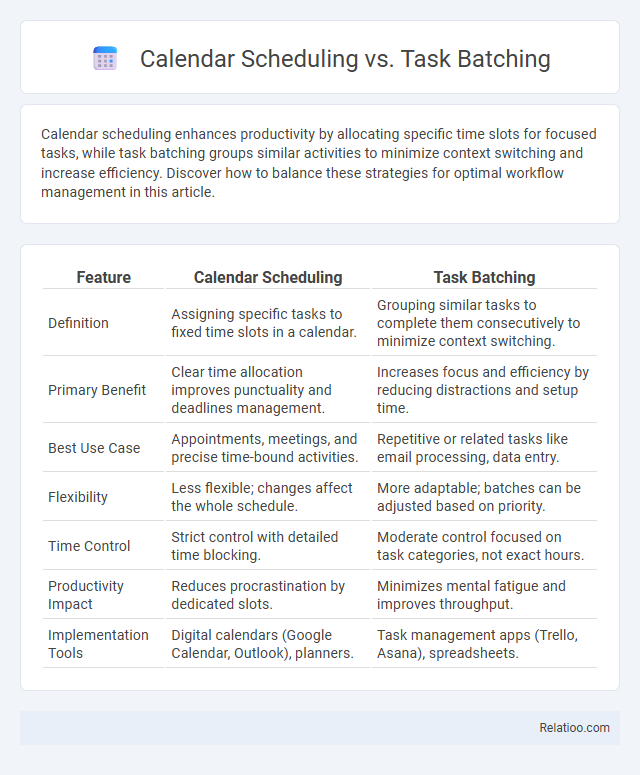Calendar scheduling enhances productivity by allocating specific time slots for focused tasks, while task batching groups similar activities to minimize context switching and increase efficiency. Discover how to balance these strategies for optimal workflow management in this article.
Table of Comparison
| Feature | Calendar Scheduling | Task Batching |
|---|---|---|
| Definition | Assigning specific tasks to fixed time slots in a calendar. | Grouping similar tasks to complete them consecutively to minimize context switching. |
| Primary Benefit | Clear time allocation improves punctuality and deadlines management. | Increases focus and efficiency by reducing distractions and setup time. |
| Best Use Case | Appointments, meetings, and precise time-bound activities. | Repetitive or related tasks like email processing, data entry. |
| Flexibility | Less flexible; changes affect the whole schedule. | More adaptable; batches can be adjusted based on priority. |
| Time Control | Strict control with detailed time blocking. | Moderate control focused on task categories, not exact hours. |
| Productivity Impact | Reduces procrastination by dedicated slots. | Minimizes mental fatigue and improves throughput. |
| Implementation Tools | Digital calendars (Google Calendar, Outlook), planners. | Task management apps (Trello, Asana), spreadsheets. |
Introduction to Calendar Scheduling and Task Batching
Calendar scheduling allocates specific time blocks for tasks, enhancing time management by providing structure and reducing decision fatigue. Task batching groups similar tasks to improve focus and efficiency, minimizing context switching and cognitive load. Both methods optimize productivity by aligning work patterns with natural attention spans and workflow rhythms.
Understanding Calendar Scheduling
Calendar scheduling enhances productivity by allocating specific time blocks for distinct activities, reducing decision fatigue and enabling better focus compared to task batching, which groups similar tasks but lacks precise time boundaries. Your ability to commit to fixed time slots in calendar scheduling improves accountability and helps prevent overcommitment, unlike confirmation methods that primarily ensure appointments are acknowledged but don't optimize time management. Understanding calendar scheduling enables more effective prioritization and time allocation, leading to improved workflow and goal achievement.
What is Task Batching?
Task batching is a time management technique that groups similar tasks together to be completed in a dedicated block of time, minimizing context switching and boosting productivity. Unlike calendar scheduling which allocates specific times for diverse activities, task batching focuses on efficiency by streamlining repetitive or related tasks. This method enhances focus and reduces decision fatigue, making it ideal for workflow optimization and improving task completion rates.
Key Differences Between Calendar Scheduling and Task Batching
Calendar scheduling organizes your day by allocating specific time slots for meetings, appointments, and tasks, ensuring structured time management. Task batching groups similar tasks together to complete them in designated periods, reducing context switching and increasing efficiency. The key difference lies in calendar scheduling's focus on time allocation across varied activities, while task batching emphasizes grouping similar tasks for continuous workflow.
Advantages of Calendar Scheduling
Calendar scheduling offers precise time allocation, helping you manage your day efficiently by blocking specific periods for important activities. It reduces the risk of overbooking and ensures deadlines are met by providing a clear visual framework for your commitments. This method also enhances productivity by minimizing distractions and enabling focused work sessions tailored to your priorities.
Benefits of Task Batching
Task batching enhances productivity by grouping similar tasks together, reducing cognitive switching and minimizing distractions. This focused approach streamlines workflow, enabling deeper concentration and faster task completion compared to calendar scheduling or frequent confirmations. By optimizing time management, task batching leads to increased efficiency and lower stress levels in professional environments.
When to Use Calendar Scheduling
Calendar scheduling excels when managing fixed appointments, deadlines, or collaborative meetings that require precise time allocation on your daily agenda. You should use calendar scheduling to ensure time-sensitive tasks and events are organized, preventing overlaps and missed commitments. This method streamlines time management by visually allocating specific time blocks, optimizing productivity and punctuality.
When to Choose Task Batching
Task batching is ideal for managing repetitive tasks that require deep focus and minimal context switching, such as responding to emails, content creation, or data entry. This approach increases productivity by grouping similar activities into dedicated time blocks, reducing cognitive load and enhancing efficiency. Choose task batching when you have a workload with homogeneous tasks that can be effectively completed in uninterrupted segments.
Combining Calendar Scheduling and Task Batching for Productivity
Combining calendar scheduling and task batching significantly enhances productivity by structuring focused blocks of time dedicated to similar tasks, minimizing context switching and reducing cognitive load. Calendar scheduling assigns specific time slots for these batched tasks, ensuring disciplined time management and preventing overlap or procrastination. Integrating both methods creates a seamless workflow that maximizes efficiency and accelerates goal completion.
Conclusion: Which Method Works Best?
Calendar scheduling maximizes productivity by allocating specific time slots for tasks, ensuring structured management of your day. Task batching enhances focus and efficiency by grouping similar activities, reducing the cognitive load of switching contexts. Confirmation techniques validate commitments and deadlines, improving accountability, but for optimal results, combining calendar scheduling with task batching offers the best balance of time management and task execution.

Infographic: Calendar Scheduling vs Task Batching
 relatioo.com
relatioo.com